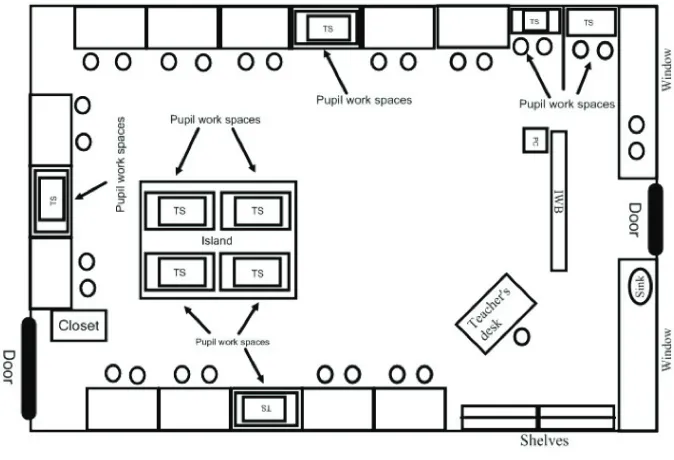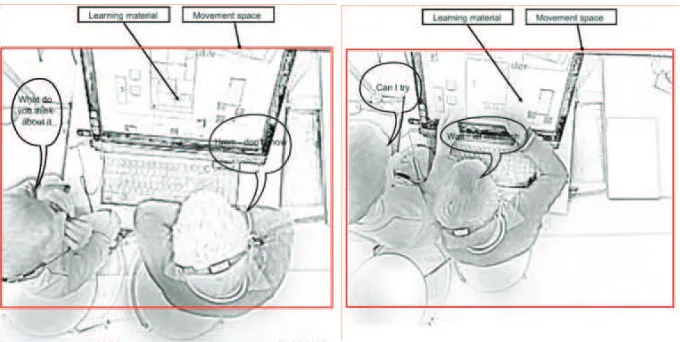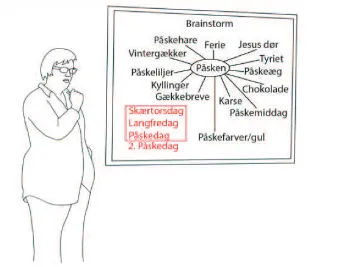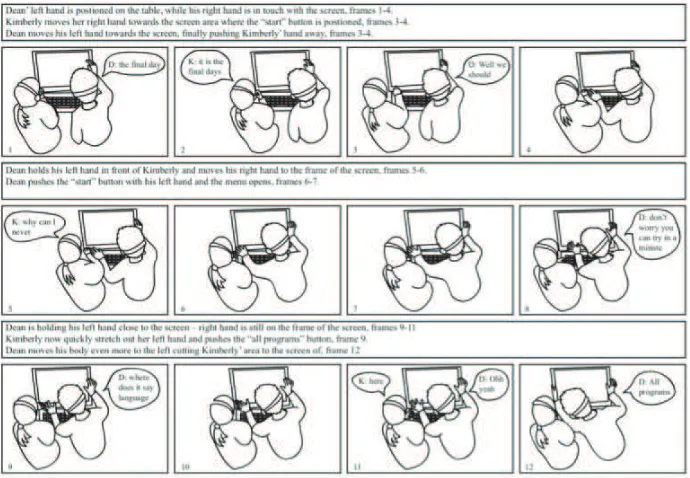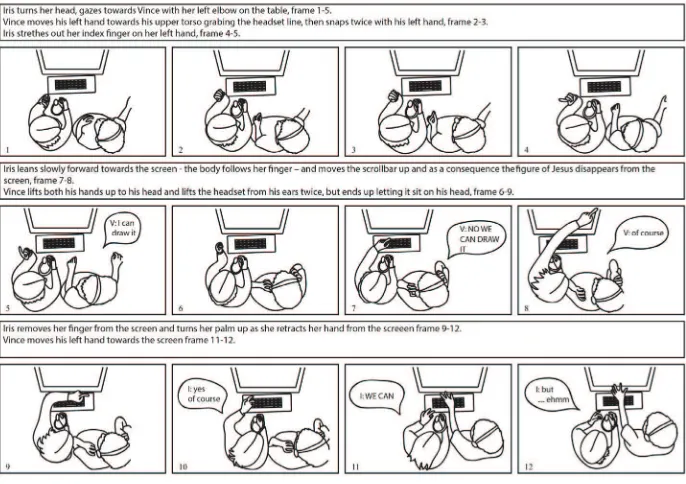Vol. 7 / No. 1
D
E
S
IG
N
S
F
O
R
LEAR
N
IN
Apart from touching the screen, what is the role of the hands for children col-laborating around touchscreens? Based on embodied and multimodal inter-action analysis of 8- and 9-year old pairs collaborating around touchscreens, we conclude that children use their hands to constrain and control access, to construct and problem solve, and to show and imitate. The analyses show how a space emerges from the interaction between the children and the touchscreen, and how their hand movements reveal intelligence-as-action. Three situa-tions with three different pairs were analysed to explore how children use their hands in activities around touchscreens, focusing in particular on how they collaborate. The analysis presented here is part of a research study on the use of touchscreens in children’s embodied and multimodal collaborative learning activities in their everyday classrooms. The general aim of the study is to con-tribute to the understanding of children’s multimodal collaborative learning activities around touchscreens.
I N T RO D U C T I O N
Apart from touching the screen, what is the role of the hands in children’s collaborative learning around touchscreens? This question seems especially relevant at a time when two quite different forces are becoming influential in public school systems across in Europe: the increasing use of touchscreen based learning tools in homes and schools and the extension of PISA to en-compass testing of children’s collaborative problem solving skills (OECD, 2013). The advent of touchscreens is apparent in a recent survey from Nor-way showing that 36% of children from 0–6 years had used tablets at home
Mind the hand: A study on children’s
embodied and multimodal collaborative
learning around touchscreens
(Guðmundsdóttir & Hardersen, 2012). Among other findings, the survey indicated that the children were primarily playing games, watching mov-ies, or viewing photos. However, the ‘activity categories’ tell us little about how the activities were actually performed or what role the hands played in the multimodal and embodied assemblage of interaction. The benefits of collaborative learning supported by computers are well-established, but the embodied and multimodal interaction of children collaborating has so far been under-researched, even in recent studies of collaboration around touchscreens (Davidsen & Christiansen, 2013). Most studies reporting on collaboration around computers have been oriented towards what Wilson (1999) describe as book and language based knowledge, or intelligence-as-information, in contrast to intelligence-as-action, which would include the use of hands in the multimodal and embodied assemblage of collaborative interaction.
This gap in the literature invites a detailed micro-level study of hand move-ments as part of an effort to understand children’s embodied and multi-modal collaborative learning around touchscreens. Specifically, by means of a detailed embodied and multimodal interaction analysis, the research question in the present study asked how 8- and 9-year old children use their hands in collaborative learning activities around touchscreens. We ad-dressed this question by analysing video footage from a research project called “Move and Learn”, in which children’s use of touchscreens for col-laborative learning activities in the classroom was explored over the course of one school year. In total, 150 hours of video footage was collected in this project and here we analyse three specific situations in which children’s hand movements were part of the multimodal and embodied assemblage of interaction. The findings presented here contribute to a recent and more general interest in embodied and multimodal aspects of learning, collabo-ration and meaning making.
R E S E A RC H B AC KG RO U N D
and embodied collaboration—the intelligence-as-action that is the pri-mary interest of this paper.
R E S E A RC H A P P ROAC H
Stahl, Koschmann, and Suthers (2006) identified three general research ap-proaches: experimental and conditional studies, iterative design studies, and descriptive studies. In respect of the first of these approaches, Davidsen and Christiansen (2013) concluded that experimental studies of interactions with various touch interfaces focused on types of talk, number of touches, and layout of the shared workspace in the case of collaborative activities. In the second category, design-related studies have presented a mixture of in-tangible and in-tangible guidelines for the use of touch-technologies in collab-orative learning activities. The third type of study has not been extensively dealt with in the research literature, but it is proposed here that descriptive studies can produce important insights into how touchscreens support em-bodied and multimodal collaborative learning. Consequently, the present study emphasises “exploring and understanding”, in particular, the process of children’s embodied and multimodal meaning making (Stahl, 2006) rather than “coding and counting”.
actions and skills develop as a multifaceted interplay of physical and bodily engagement with situations, peers, and materials.
In similar fashion, Roth (2001) showed that children explain scientific con-cepts through gestures (intelligence-as-action) before they can articulate the concepts in language (intelligence-as-information). However, while in that research the hand is seen as an individual tool rather than as a social tool or as a tool for collaboration as a part of multimodal learning activities, Vygotsky (1978) had already stressed that the gestures of an infant are so-cially oriented: The simple gesture of pointing causes the mother or father to respond, relying on the surroundings to interpret the child’s needs. Re-cently, researchers studying embodied interaction, including Streeck (2008, 2013), have shown how car mechanics use hand movements, their bodies, and the material at hand in complex acts of meaning making. Instead of labelling their actions as “embodied”, Streeck showed how peers’ bodies-in-motion in the situation were crucial for their negotiation of meaning and building of the activity. In spite of these findings, researchers continue to study gestures and categories of gestures (e.g., Sakr, Jewitt, & Price, 2014) in a way that reduces gestures to “something to look for in the data”. Just like the coding and counting studies of dialogue in collaborative activities, cate-gories of gestures are abstracted from the situated context of action. Against this, the present analysis takes an inductive approach, studying the ways in which the hands and body move in a given situation, towards a situated and embodied practice of meaning making. Streeck (2013, p. 74) argued that “the meanings manufactured by human hand gestures are more than exter-nalizations of mental structures and processes: they follow from the ways in which human hands in practical action make and experience the world.” Thus, the present study does not assume that hand movements denote spe-cific types/categories of gestures in interaction: rather, hand movements are understood as a semiotic resource in the embodied practices (Goodwin, 2000) of children’s process of meaning making around touchscreens.
C O N T E X T, DATA, A N D A NA LY T I C A L M O D E L
Learn” (Davidsen & Georgsen, 2010).1 In general, this project focused on exploring the ways in which touchscreens can support collaboration, in-teraction, and experimental forms of learning in classroom settings. The touchscreens were placed in the classrooms along the walls of the room and on a small island in the centre (see Figure 1). The main pedagogical/didacti-cal idea was to let children work together in pairs around the touchscreens, with the teacher playing the role of guide/facilitator/designer of the chil-dren’s collaboration.
Figure 1: Classroom overview
During the assignment, nine hours and 32 minutes of video footage was re-corded, which was transcribed using Transana (Woods & Fassnacht, 2013). At first, the transcripts were oriented towards what was said, but as interest shifted to the role that the children’s hands play in collaborative learning activities, a micro-level embodied and multimodal transcription practice was developed (Davidsen & Christiansen, 2013; Davidsen & Vanderlinde, 2014a,b), focusing on language, hand movements, and the materials used in the activity. As already mentioned, the main goal of developing the mul-timodal transcripts was to overcome the limitations found in related work, in which researchers tended to focus on the “audio channel” while neglect-ing the embodied aspects of children’s meanneglect-ing makneglect-ing (Rowe, 2012). For this reason, the selection criteria emphasised the significance and mean-ing within a narrative account, as opposed to probabilistic concepts of fre-quency and representativeness (Derry et al., 2010). From the transcripts, the selected situations show the pairs engaging in embodied and multimodal interactions around the touchscreen. Figure 2 illustrates the analytical unit: the space between the children’s hands when they interact with the screen to manipulate screen objects, and when they interact with each other in communication by hand movement.
Figure 2 shows two instances of a pair sitting around a touchscreen, with learning material displayed on the screen. They could talk about the ma-terial, ask each other questions, or call for help. Likewise, both had their hands free; they could move towards the screen, point at something on the screen, or manipulate the learning material and interface on screen. In ad-dition, they could interrupt each other with their hands or repair each oth-er’s work. They could also orient themselves towards the overall classroom environment, asking other children for help or commenting on what other children were doing. In summary, the unit of analysis comprises the way a pair used their hands, language, and supporting tools to organise their interaction, and how they defined, reconfigured, and accomplished assign-ments. In our analysis, we zoomed in on the children’s meaning-making as a complex of what they said, what they did with their hands (and bodies), and how they oriented towards and made use of the learning material pres-ent on the touchscreen. In particular, we analysed the ways hands shape children’s collaborative activities around touchscreens, as part of the em-bodied and multimodal interaction.
A NA LY S I S
The analysis opens with an introduction to the overall activity, including a brief description of the learning material designed by the teacher. After-wards, we present three situations which capture and exemplify the role hands play in children’s activities around touchscreens. The primary goal of the analyses of the three different situations is to explore how hand move-ments shape children’s embodied and multimodal collaborative learning activities.
What do you know about Easter, children? (L2)
Figure 3: Brainstorm activity (in Danish)
the 8- and 9-year olds collaborating around touchscreen in their class-room, three pairs were selected: Dean and Kimberly, Iris and Vince, and Nathalie and Peter. Rather than considering their academic competences or skills; the aim was to show how the hand shapes their collaborative activity around touchscreens. Each situation will be briefly introduced, and we will then analyse the role of hand movements as a part of the children’s embod-ied and multimodal interaction in the situation. The three situations are also used to make visible that each pair contingently make relevant differ-ent semiotic resources collaborating around touchscreens, e.g. the children produced different situations with the present and the available resources in their activity.
Dean and Kimberly–“This takes forever”
Dean and Kimberly showed signs of frustration and impatience from the very beginning, finding that the computer was loading the webpage slowly. To troubleshoot, Dean opened the tool for diagnosing the network connec-tion, but Kimberly was not completely satisfied and raised her voice say-ing, “DEAN”. The central IWB then played a loud noise, which made Dean, Kimberly, and the rest of children laugh out loud.
The role of hands
Figure 4: Dean and Kimberly
said: “Dean is moving my hand away from the screen all the time”. This statement further validates our interpretation of the way their hands are used in the collaborative multimodal activity around the touchscreen.
Iris and Vince – “Didn’t it sound fine?”
Iris and Vince turned on the computer and waited a couple of minutes while it was loading. Meanwhile, Vince asked Iris what she did on her holi-days. Iris went through each of the days, but she never asked Vince the re-ciprocal question. As soon as Iris finished talking, Vince said, “I will find the program and such”, taking the initiative to get their activity started by using talk before using hands. However, Iris and Vince both interacted with the screen and did not constrain each other’s access.
The role of hands
Figure 5: Iris and Vince
accepted the gestural invitation from Iris prior to her verbal turn, and he then drew a rock to cover Jesus, using the freehand drawing tool.
In this case, hands were not used to control access to the screen but served two constructive purposes: as a means of creating the scene on the screen and as a means of communication in the process of configuring the new task. In their collaborative activity, the pair used the movement space to en-gage in a shared construction of a conception of a problem through action and information. In other words, the touchscreen augmented both their intelligence-as-information and their intelligence-as-action. Hands shaped their activity in a positive manner, and they constructed a space for mutual engagement in the problem solving activity.
Peter and Nathalie – “the wrong internet”
Peter and Nathalie faced a technical problem after they turned the touch-screen on. Then, they found that the printout of the text was stapled incor-rectly, causing Nathalie to go to Anne, their teacher. Nathalie returned and told Peter that Anne said they should tear the papers apart and staple them correctly. Meanwhile, the touchscreen displayed an error message, and both of them turned towards this issue. The desktop showed several Internet icons; Nathalie said, “It is the wrong Internet”, which we interpret to mean that they were expecting a particular screen while navigating between dif-ferent windows. Finally, they found the file containing their learning mate-rial; they did not read the list of tasks aloud. Nathalie acted as if she thought they should use the text-to-speech software on the list of tasks. However, the content on this slide was locked, and they could not mark up the text. Nathalie called for the teacher’s help.
The role of hands
Figure 6: Nathalie and Peter
In this part of their activity, we see signs of the role of the hand in their em-bodied and multimodal collaborative activity. Nathalie had just marked up the text when she moved her right hand to a position above the keyboard, 10 centimeters from the screen (frames 1–2, Figure 5). Without saying a word, Peter moved his right hand forward while stretching his index finger to push the play icon (frames 3–4). Then, Nathalie laid her hand down on the table, and Peter moved his hand to the headset.
After Nathalie and Peter had listened to the text-to-speech reading, Nathalie marked up the text again (frames 1–2, Figure 6), but this time she pushed the play icon (frames 3–4). This time, she did not retract her hand, and she imitated Peter’s action, pushing “play” as an addition to her turn.
Figure 7: Nathalie and Peter
text-to-speech reading for 1 minute and 11 seconds. Here, we see the children learning together by following each other’s hand movements without say-ing anythsay-ing – they are in fact co-operatsay-ing (Goodwin, 2013) the screen through their bodies, inhabiting and mutually monitoring the situation. Nathalie displayed intelligence-as-action by imitating Peter’s action, and it is clear that the touchscreen setting offered room for imitation and the de-velopment of intelligence-as-action. The hands shaped the children’s activ-ity, providing a space for imitation, co-operation and learning.
In summary, these three examples demonstrate how the hand can shape children’s collaborative activities around a touchscreen. Essentially, the hand can be used to constrain and control access, to construct and problem solve, and to show and imitate. In addition, it is also clear that the three pairs, working with the same learning material, engaged differently in the collaborative assignment. In other words, each pair made relevant different semiotic resources in their configuration of the context (Goodwin, 2000) through their collaborative activities around the touchscreens.
M I N D T H E H A N D I N C O L L A B O R AT I V E AC T I V I T I E S
AC K N OW L E D G E M E N T S
We are grateful for the openness and collaborative spirit of the teachers, children, and management at Western State School, who made this research possible. Thanks also to Rasmus Raun Paulsen and Camilla Hvass, students at Aalborg University, for making the illustrations. Thanks as well to the anonymous reviewer for valuable suggestions.
E N D N OT E S
1 The names of the school and all the participants have been changed by the
authors to secure and protect their identity. School administration handled the consent forms, which all parents signed.
2 Figures 4–7 show stills from the video footage of the selected situations,
including transcribed talk in speech bubbles, with movements described above the photos. Each frame is numbered; three frames are equal to one second of time.
R E F E R E N C E S
Alant, L., Engan, B., Otnes, H., Sandvik, M., & Schwebs, T. (2003). Samhandling med, foran og via
skjermen: småskoleeleven på veimot digital kompetanse. Oslo: Forsknings- og Kompetansenettverk
for IT i utdanning: i samarb. med Unipub.
Goodwin, C. (2000). Action and embodiment within situated human interaction. Journal of Pragmatics, 32(10), 1489–1522.
Goodwin, C. (2013). The co-operative, transformative organization of human action and knowledge.
Journal of Pragmatics, 46(1), 8–23.
Crook, C. (1994). Computers and the collaborative experience of learning. London; New York: Routledge.
Davidsen, J., & Christiansen, E. T. (2013). The Benefits of Single-Touch Screens in Intersubjective Mean-ing MakMean-ing. In N. Rummel, M. Kapur, M. Nathan, & S. Puntambekar (Eds.), To See the World and a Grain of Sand: Learning across Levels of Space, Time, and Scale (Vol. 2, p. 10). International Society of the Learning Sciences (ISLS).
Davidsen, J., & Georgsen, M. (2010). ICT as a tool for collaboration in the classroom – challenges and lessons learned. Design for Learning, 3(1-2), 54–69.
Davidsen, J., & Vanderlinde, R. (2014b). Exploring What Touch-Screens Offer From The Perspectives Of Children: Methodological Challenges. In G. B. Gudmundsdottir & K. B. Vasbø (Eds.), Methodological
challenges when exploring digital learning spaces in education. Sense Publishers.
Derry, S., Pea, R., Barron, B., Engle, R., Erickson, F., Goldman, R., …Sherin, B. (2010). Conducting Video Research in the Learning Sciences: Guidance on Selection, Analysis, Technology, and Ethics. Journal of
the Learning Sciences, 19(1), 3–53.
Greiffenhagen, C., & Watson, R. (2009). Visual repairables: analysing the work of repair in human–com-puter interaction. Visual Communication, 8(1), 65.
Guðmundsdóttir, G. B., & Hardersen, B. (2012). Småbarns digitale univers: 0-6 åringers tilgang til
og bruk av digitale enheter på fritiden: panelundersøkelseutført høsten 2011. Oslo: Senter for IKT i
utdanningen.
Higgins, S., Mercier, E., Burd, E., &Hatch, A. (2011). Multi-touch tables and the relationship with col-laborative classroom pedagogies: A synthetic review. International Journal of Computer-Supported
Collaborative Learning, 6(4), 515–538.
Koschmann, T., & LeBaron, C. (2002). Learner Articulation as Interactional Achievement: Studying the Conversation of Gesture. Cognition and Instruction, 20(2), 249–282.
Nielsen, J. (1987). Datamater og erkendelsesprocesser: en teoretisk analyse af
erkendelsespara-digmer, set i relation til nogle 8. klasse elevers arbejde med datamater. Institut for Pædagogik og
Psykologi, Danmarks Lærerhøjskole.
OECD. (2013). Pisa 2015 Draft Collaborative Problem Solving Framework. Retrieved from http:// www.oecd.org/pisa/pisaproducts/Draft%20PISA%202015%20Collaborative%20Problem%20Solv-ing%20Framework%20.pdf
Papert, S. (1980). Mindstorms: children, computers, and powerful ideas. New York: Basic Books. Roschelle, J., & Teasley, S. D. (1995).Constructing a Joint Problem Space: The Computer as a Tool for Sharing Knowledge. Retrieved from http://ctl.sri.com/publications/downloads/JointProblemSpace.pdf
Roth, W.-M. (2001). Gestures: Their Role in Teaching and Learning. Review of Educational Research, 71(3), 365–392.
Rowe, D. W. (2012). The Affordances of Multimodal Interaction Analysis for Studying the Beginnings of Literacy. Retrieved from http://nctear2013.ehe.osu.edu/files/2013/01/rowe-2012-affordances-of-multimodal-interaction-analysis-cmp.pdf
Sakr, M., Jewitt, C., & Price, S. (2014). The semiotic work of the hands in scientific enquiry. Classroom
Discourse, 5(1), 51–70.
Sennett, R. (2008). The craftsman. Yale University Press.
Stahl, G., Koschmann, T., & Suthers, D. (2006). CSCL: An Historical Perspective Computer-supported collaborative learning. In R. K. Sawyer (Ed.), Cambridge handbook of the learning sciences (pp. 409– 426). Cambridge handbook of the learning sciences. Cambridge, UK: Cambridge University Press. Streeck, J. (2008). Gesturecraft : Manufacturing understanding. Amsterdam: J. Benjamins Pub. Co. Streeck, J. (2013). Interaction and the living body. Journal of Pragmatics, 46(1), 69–90.
Streeck, J., Goodwin, C., & LeBaron, C. D. (Eds.). (2011). Embodied interaction : language and body in
the material world. New York: Cambridge University Press.
Vygotsky, L. (1978). Mind in society: the development of higher psychological processes. Cambridge Mass.: Harvard University Press.
Wegerif, R., Littleton, K., & Jones, A. (2003). Stand-alone computers supporting learning dialogues in primary classrooms. International Journal of Educational Research, 39(8)
Wilson, F. R. (1999). The hand: how its use shapes the brain, language, and human culture. New York: Vintage Books.
Editorial:R I K K E Ø R N G R E E N 5
SUSANNE KJÄLLANDER & FARZANEH MOINIAN:
Digital tablets and applications in preschool.
Preschoolers’ creative transformation of didactic design
JAKOB DAVIDSEN & ELLEN CHRISTIANSEN:
Mind the hand: A study on children’s embodied and multimodal collaborative learning around touchscreens
BIRGIT TE HOLM SØRENSEN & KARIN TWEDDELL LEVINSEN:
Digital Production and Students as Learning Designers
S T I G TO K E G I S S E L:
